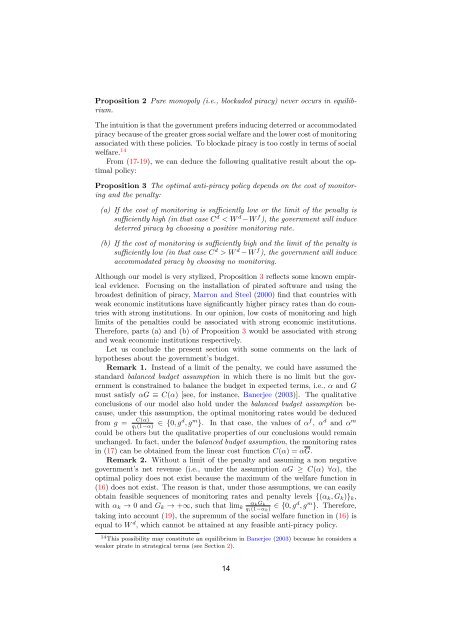Download PDF - Ivie
Create successful ePaper yourself
Turn your PDF publications into a flip-book with our unique Google optimized e-Paper software.
Proposition 2 Pure monopoly (i.e., blockaded piracy) never occurs in equilibrium.<br />
The intuition is that the government prefers inducing deterred or accommodated<br />
piracy because of the greater gross social welfare and the lower cost of monitoring<br />
associated with these policies. To blockade piracy is too costly in terms of social<br />
welfare. 14<br />
From (17-19), we can deduce the following qualitative result about the optimal<br />
policy:<br />
Proposition 3 The optimal anti-piracy policy depends on the cost of monitoring<br />
and the penalty:<br />
(a) If the cost of monitoring is sufficiently low or the limit of the penalty is<br />
sufficiently high (in that case C d < W d −W f ), the government will induce<br />
deterred piracy by choosing a positive monitoring rate.<br />
(b) If the cost of monitoring is sufficiently high and the limit of the penalty is<br />
sufficiently low (in that case C d > W d − W f ), the government will induce<br />
accommodated piracy by choosing no monitoring.<br />
Although our model is very stylized, Proposition 3 reflects some known empirical<br />
evidence. Focusing on the installation of pirated software and using the<br />
broadest definition of piracy, Marron and Steel (2000) find that countries with<br />
weak economic institutions have significantly higher piracy rates than do countries<br />
with strong institutions. In our opinion, low costs of monitoring and high<br />
limits of the penalties could be associated with strong economic institutions.<br />
Therefore, parts (a) and (b) of Proposition 3 would be associated with strong<br />
and weak economic institutions respectively.<br />
Let us conclude the present section with some comments on the lack of<br />
hypotheses about the government’s budget.<br />
Remark 1. Instead of a limit of the penalty, we could have assumed the<br />
standard balanced budget assumption in which there is no limit but the government<br />
is constrained to balance the budget in expected terms, i.e., α and G<br />
must satisfy αG ≡ C(α) [see, for instance, Banerjee (2003)]. The qualitative<br />
conclusions of our model also hold under the balanced budget assumption because,<br />
under this assumption, the optimal monitoring rates would be deduced<br />
from g =<br />
C(α)<br />
q ∈ {0, i(1−α) gd , g m }. In that case, the values of α f , α d and α m<br />
could be others but the qualitative properties of our conclusions would remain<br />
unchanged. In fact, under the balanced budget assumption, the monitoring rates<br />
in (17) can be obtained from the linear cost function C(α) = αG.<br />
Remark 2. Without a limit of the penalty and assuming a non negative<br />
government’s net revenue (i.e., under the assumption αG ≥ C(α) ∀α), the<br />
optimal policy does not exist because the maximum of the welfare function in<br />
(16) does not exist. The reason is that, under those assumptions, we can easily<br />
obtain feasible sequences of monitoring rates and penalty levels {(α k , G k )} k ,<br />
α k G k<br />
q i(1−α k ) ∈ {0, gd , g m }. Therefore,<br />
with α k → 0 and G k → +∞, such that lim k<br />
taking into account (19), the supremum of the social welfare function in (16) is<br />
equal to W d , which cannot be attained at any feasible anti-piracy policy.<br />
14 This possibility may constitute an equilibrium in Banerjee (2003) because he considers a<br />
weaker pirate in strategical terms (see Section 2).<br />
12

















